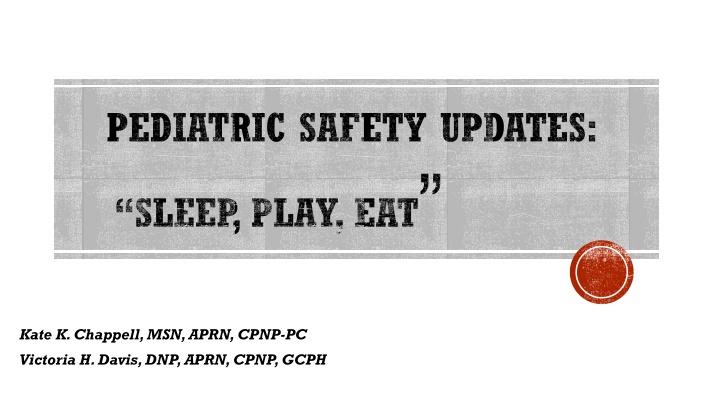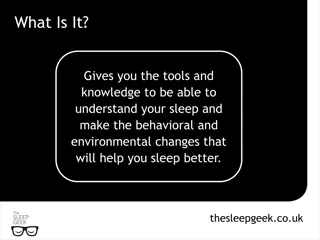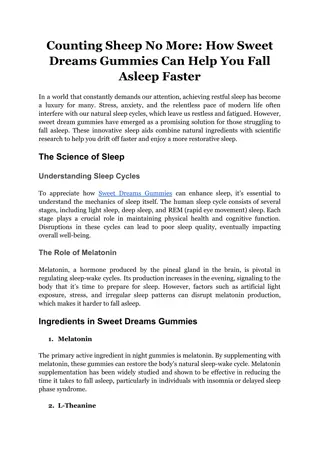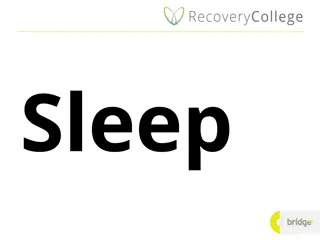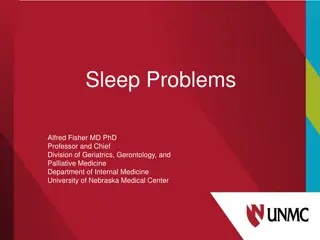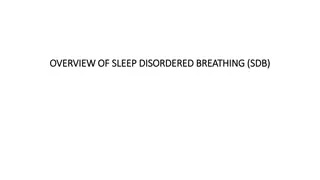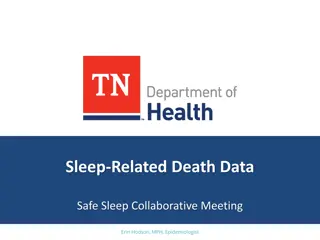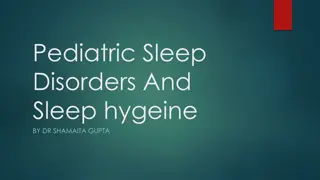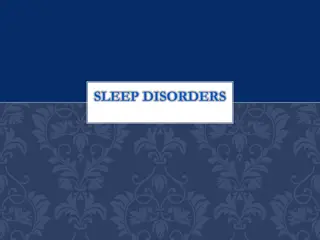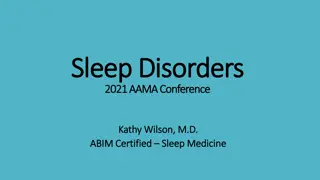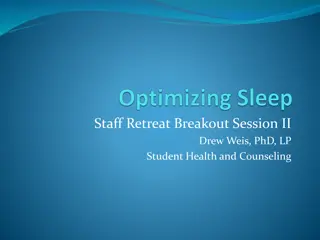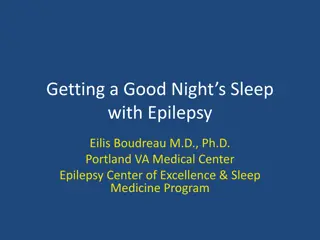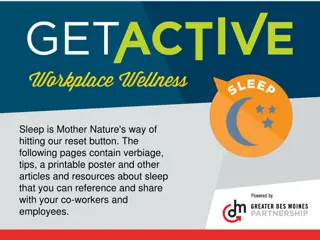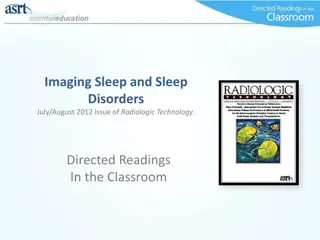Pediatric Safety Updates: Sleep-Related Infant Deaths Overview
Sleep-related infant deaths, including Sudden Infant Death Syndrome (SIDS) and accidental suffocation, remain a significant concern with over 3500 infant deaths in the US annually. Risk factors such as prone positioning, bed-sharing, premature birth, and maternal tobacco use contribute to these tragedies. Understanding the scope of the problem and Sudden Unexplained Infant Death is vital for prevention strategies.
Download Presentation

Please find below an Image/Link to download the presentation.
The content on the website is provided AS IS for your information and personal use only. It may not be sold, licensed, or shared on other websites without obtaining consent from the author.If you encounter any issues during the download, it is possible that the publisher has removed the file from their server.
You are allowed to download the files provided on this website for personal or commercial use, subject to the condition that they are used lawfully. All files are the property of their respective owners.
The content on the website is provided AS IS for your information and personal use only. It may not be sold, licensed, or shared on other websites without obtaining consent from the author.
E N D
Presentation Transcript
PEDIATRIC SAFETY UPDATES: SLEEP , PLAY, EAT Kate K. Chappell, MSN, APRN, CPNP-PC Victoria H. Davis,DNP, APRN, CPNP, GCPH
SCOPE OF THE PROBLEM 3500+ US infant deaths/year due to sleep-related infant deaths. Includes Sudden Infant Death Syndrome accidental suffocation and strangulation in bed and undetermined/ill-defined causes Initial decrease in the 1990s, no appreciable difference in recent years Similar risk factors for SIDS and other sleep-related causes of infant death (Moon, et al., 2016)
SCOPE OF THE PROBLEM SC infant mortality rates 1996: 8.3 per 1,000 among all races (5.5 among Whites; 13 among Black & other races) 2015: 7 per 1,000 among all races (4.8 among Whites; 11.2 among Black & other races) 2015 SC Infant Mortality Counts 405 total 1stR/t short gestation & LBW (79) 2ndCongenital malformations (72) 3rdAccidents (38) 4thSIDS (28) (SCDHEC, 2016)
Sudden Infant Death Syndrome: sudden death of an infany younger than 1 year that remains unexplained after a thorough case investigation, including performance of a complete autopsy, examination of the death scene, and review of the clinical history. Sudden Unexplained Infant Death: any sudden and unexpected infant death, whether explained (such as accidental suffocation or strangulation) or unexplained (such as SIDS). (Federico, et al., 2016)
RISK FACTORS FOR SUID/OVERLAP WITH SIDS More common among ethnic racial minorities Difference in prevalence of prone positioning and bed-sharing potential link Males Premature birth Low birth weight Recent infection Young maternal age Maternal tobacco or drug use High maternal parity Crowded living conditions (Federico, 2016)
SC 2015 ACCIDENTAL AND SUDDEN UNEXPLAINED INFANT DEATHS 38 deaths due to accidents: 35 from accidental suffocation & strangulation in bed 1 from other accidental threats to breathing 2 other accidents (not transportation, drowning, or poisoning) 78 sudden unexplained infant deaths: 35 from accidental suffocation & strangulation in bed 28 from SIDS 4 from hanging, strangulation, and suffocation of undetermined intent 11 ill-defined or unspecified (SCDHEC, 2016)
INFANT MORTALITY BY CAUSE ACCORDING TO AGE Post- Neonatal (28-364 days) SC 2015 Counts < 1 day 1-6 days 7-27 days Total Accidents 1 1 2 34 38 SIDS - 1 - 27 28 Greatest period of risk for unsafe sleep-related deaths: 4-8 months old Chart: SCDHEC, 2016; other: Moon, 2016
PROGRESS? FROM 2014 TO 2015 IN SC INFANT MORTALITY . . . SC Changes from 2014 to 2015: Cause of infant deaths Accidents -5% (2) SIDS -9.7% (3) Accidents & SUIDs: +4 suffocation & strangulation in bed -2 accidental threats to breathing -3 SIDS (SCDHEC, 2016)
TOWARDS OUTCOME EQUITY Infant Mortality rates per 1,000 births SC 2013- 2015 Black & other races White SIDS 0.5 0.4 0.5 Accidents 0.6 0.5 0.7 (SCDHEC, 2016)
NOW, TO PREVENTION . . . 2016 AAP GUIDELINE UPDATE Back to Sleep for Every Sleep Anatomically logical for airway GER? Prematurity?
NOW, TO PREVENTION . . . 2016 AAP GUIDELINE UPDATE Use a firm sleep surface CPSC-approved surfaces such as . . . What about slings? What about CO2 reducing products?
NOW, TO PREVENTION . . . 2016 AAP GUIDELINE UPDATE Breastfeeding is recommended. Reduced risk of SIDS 6 months per AAP, exclusively BM if possible
NOW, TO PREVENTION . . . 2016 AAP GUIDELINE UPDATE It is recommended that infants sleep in the parents room, close to the parents bed, but on a separate surface designed for infants, ideally for the first year or life, but at least for the first 6 months. What about bed sharing devices? What about co-sleeping, bed sharing? Multiple infants co-sleeping?
NOW, TO PREVENTION . . . 2016 AAP GUIDELINE UPDATE Keep soft objects and loose bedding away from the infant s sleep area to reduce the risk of SIDS, suffocation, entrapment, and strangulation. What about bumper pads? Safest sleep clothing plans
NOW, TO PREVENTION . . . 2016 AAP GUIDELINE UPDATE Consider offering a pacifier. Not attached to child s clothing Avoid smoke exposure during pregnancy and after birth.
NOW, TO PREVENTION . . . 2016 AAP GUIDELINE UPDATE Avoid overheating and head covering in infants. No more than 1 layer more than an adult would have in the environment Regular Prenatal Care
NOW, TO PREVENTION . . . 2016 AAP GUIDELINE UPDATE Immunizations according to AAP and CDC recommendations Avoid commercial products that are inconsistent with the safe sleep recommendations
RESOURCES FOR SAFE SLEEP ENVIRONMENTS Cribs for Kids: http://www.cribsforkids.org Families receive training & may qualify for a Pack n Play National program originating in PA in 1998 10 SC partner coalitions Currently seeking funding for statewide implementation HALOS: http://www.charlestonhalos.org/ Focus is on supporting kinship caregivers Covering the Lowcountry Sister programs in Dillon and Lancaster counties Cribs may be available as part of their program services
GUN SAFETY AAP Recommendations: HCPs counsel parents and children about access in/out of home Incorporate ?s with annual PE Safe gun storage Gun Storage Options (What are the Risks?): Trigger Locks Gun cases/boxes Gun safes (fingerprint) Concealed carry purses
SWIM SAFETY AAP Recommendations (Pools and Spas): Never leave alone (in or near) ADULT supervision ( touch supervision ) Gate alarms/latches (self-close, self-latch) Avoid FLOATIES Swim Lessons AAP Recommendations (Open Water): Buddy Up No Diving Education (AAP, Sun and Water Safety , 2016) http://s869.photobucket.com/user/collingwood_ 9/media/Animals/Dogs/dog1.jpg.html
SWIM SAFETY AAP Recommendations (Boating): Life Jacket ALWAYS Education (drugs, alcohol) License Appropriate flotation devices (AAP, Sun and Water Safety , 2016) http://farm8.staticflickr.com/7044/6976783689_c20cd3cd62_z.jpg
WATER SAFETY Accidents Can Happen: Puddles Mop Buckets Bath tubs Showers Sinks Toilets (AAP, Sun and Water Safety , 2016)
CAR SEAT SAFETY (AAP, Car Seats and Obese Children , 2016)
CAR SEAT SAFETY TIPS AAP Recommendations: The latch system vs SEAT BELT (lower anchors and tethers for children) system Slouching? Blanket rolls/diapers No padding on back ATTIRE Weight Approved Preemies Obesity https://d2pu2bk1b66iw6.cloudfront.net/photos/20 14/12/10/6-86300-puffy-pink-baby- 1418253965.jpg (AAP, Car Seats and Obese Children , 2016)
CAR SEAT DIFFERENCES Educate our Families: Rear Facing only 22-45lbs Usually part of stroller system Base is left in car Car Seat Approved Brands https://www.healthychildren.org/English/saf ety-prevention/on-the-go/pages/Car-Safety- Seats-Product-Listing.aspx Convertible Rear and/or forward facing Can be used longer No separate base 40-50lbs 3-in-1 Rear and/or forward facing and/or booster Does it fit? No separate base 40-50lbs (AAP, Car Seats and Obese Children , 2016)
HOT NEWS AAP Recommendations HEAT STROKE FACTS HCPs are key in reducing death rates Educating ALL parents Leading cause of non-crash vehicle deaths for <15yrs/old Child s body heats 3-5x faster than adult End organ shut down begins at 104F Can occur with outside temp of 57F Education Points Can happen to anyone Back seat checks Car locks (?) Placement of personal items https://www.healthychildren.org/English/safety-prevention/on-the-go/Pages/Prevent-Child-Deaths-in-Hot-Cars.aspx (AAP, Prevent Child Deaths in Hot Cars , 2016)
HOT NEWS Heat Stroke Statistics Total number of U.S. heatstroke deaths of children left in cars, 2016: 39 Total number of U.S. heatstroke deaths of children left in cars, 2015: 24 Total number of U.S. heatstroke deaths of children left in cars, 1998-present: 700 (Null, 2016)
SCREEN TIME OLD AAP Recommendations Limit total amount of screen time to <1-2 hours/day No screen time for <2 years old No screens in bedroom Monitor access Est. reasonable but firm rules (AAP, Media Use , 2016)
SCREEN TIME NEW GUIDELINES NEW 2016 AAP Recommendations HCPs and parents work together to reduce exposure Develop Family Media Plan Account for Health, Education, Entertainment Ask 2 media ?s Age-appropriate counseling at annual PE Teens (increased risk for obesity, drugs, sex) Detailed history Patients w/aggressive behavior, obesity, drugs/alcohol/smoking, poor grades (AAP, Media Use , 2016)
SCREEN TIME NEW GUIDELINES NEW 2016 AAP Recommendations Prioritize unplugged time (infants & toddlers) High-Programming (PBS, Sesame) for 18m/o+ <18m/o avoid, except video chat 2-5y/o 1 hour/day 6y/o+, provide boundaries Media shouldn t take the place of sleep, activity or hygiene Media free times (ie. Dinner, driving) (AAP, Media Use , 2016)
HEAD TRAUMA Obey Road Rules Fitted Helmets BICYCLES 2015: 80 males or 10%, 11 females or 1%, n=817 2001-2003: 5-14y/o only 48% wore helmet Safety Manual Education ATV 2014: 93,700 ATV ER Injuries in U.S.; 26% < 16y/o (CDC, Head Injuries , 2015)
PEANUT ALLERGIES OLD AAP Recommendations 2000 Children < 3y/o should avoid peanuts 2008 No evidence in delaying intro solid food past 4-6 months http://www.webdonuts.com/comics/2014-10-06-Peanut.jpg No recommendation when to introduce highly allergenic foods Peanuts Eggs Fish Tree nuts Emphasis on parents of children at risk for allergies to consult with allergen prior to starting highly allergenic foods (Greenhawt, 2017)
PEANUT ALLERGIES OLD AAP Recommendations 2000 Children < 3y/o should avoid peanuts 2008 No evidence in delaying intro solid food past 4-6 months http://www.webdonuts.com/comics/2014-10-06-Peanut.jpg No recommendation when to introduce highly allergenic foods Peanuts Eggs Fish Tree nuts Emphasis on parents of children at risk for allergies to consult with allergen prior to starting highly allergenic foods (Greenhawt, 2017)
PEANUT ALLERGIES NEW AAP Recommendations Guideline #1 High Risk Infants (Severe eczema and/or egg allergy): Introduce peanuts as early as 4-6 months of age Must show successful solid food feeding prior to Strong Recommendation for allergy testing prior to (SPT, IgE, sIgE) sIgE > 0.35 refer to specialist Strong Recommendation for NOT multiple food allergy testing Supervised feeding based on test results 6-7 grams peanut protein given in 3+ feedings/week (Greenhawt, 2017)
PEANUT ALLERGIES NEW AAP Recommendations Guideline #2 Infants (Mild to moderate eczema): Risk for peanut allergy Introduce peanuts around 6 months of age Must show successful solid food feeding prior to No need for supervised feedings (Greenhawt, 2017)
PEANUT ALLERGIES NEW AAP Recommendations Guideline #3 Infants (Without eczema or food allergy and no increased risk): Introduce peanuts freely in diet with other solid foods Must show successful solid food feeding prior to No need for supervised feedings http://1.bp.blogspot.com/- JFOjDHpAHUg/T1rNQy5cyYI/AAAAAAAAA_ c/CfHucEwjfDA/s1600/Snoopy_Dancing_by_ jessie4508.jpg (Greenhawt, 2017)
REFERENCES AAP. (2016). American Academy of Pediatrics Announces New Recommendations for Children's Media Use. American Academy of Pediatrics. Retrieved from https://www.aap.org/en-us/about- the-aap/aap-press-room/pages/american-academy-of-pediatrics-announces-new- recommendations-for-childrens-media-use.aspx AAP (2015). Car Seats and Obese Children: Suggestions for Parents. American Academy of Pediatrics. Retrieved from https://www.healthychildren.org/English/safety-prevention/on-the- go/Pages/Car-Safety-Seats-and-Obese-Children-Suggestions-for-Parents.aspx AAP (2016). Prevent Child Deaths in Hot Cars. American Academy of Pediatrics. Retrieved from https://www.healthychildren.org/English/safety-prevention/on-the-go/Pages/Prevent-Child- Deaths-in-Hot-Cars.aspx AAP (2016). Sun and Water Safety Tips. American Academy of Pediatrics. Retrieved from https://www.aap.org/en-us/about-the-aap/aap-press-room/news-features-and-safety- tips/Pages/Sun-and-Water-Safety-Tips.aspx CDC. (2017). Gun Violence by the Numbers. Centers for Disease Control and Prevention. Retrieved from https://everytownresearch.org/gun-violence-by-the-numbers/ CDC (2015). Head Injuries and Bicycle Safety. Centers for Disease Control and Prevention. Retrieved from https://www.cdc.gov/healthcommunication/toolstemplates/entertainmented/tips/headinjuries. html
REFERENCES Dowd, M. Denise, and Robert D. Sege. "Firearm-Related Injuries Affecting the Pediatric Population." Pediatrics 130, no. 5 (November 2012). http://pediatrics.aappublications.org/content/130/5/e1416.full. Federico, M. J., et al. (2016). Respiratory tract and Mediastinum. In Current Diagnosis and Treatment Pediatrics (Eds. Hay, W. W., Levin, K. J., Deterding, R. R., & Abzug, M. J.). 23rd ed. NY, NY: McGraw Hill. Greenhawt, M. (2017, January 05). New Guideline for Prevention of Peanut Allergy: Where We Stand Now in Preventing Food Allergies. Retrieved February 01, 2017, from http://www.medscape.com/viewarticle/874075 Horman, B. G. (2016, April 14). 6 Ways To Safely Store Your Firearms. Retrieved February 01, 2017, from https://www.nrafamily.org/articles/2016/4/14/6-ways-to- safely-store-your-firearms/# IIHS. (2016). Pedestrians and bicyclists. Insurance Institute for Highway Safety. Retrieved from http://www.iihs.org/iihs/topics/t/pedestrians-and- bicyclists/fatalityfacts/bicycles/2015 Moon, R. Y., Darnall, R. A., Feldman-Winter, L., Goodstein, M. H., and Hauck, F. R. (2016). SIDS and other sleep-related infant deaths: Updated 2016 recommendations for a safe infant sleeping environment. Pediatrics, 138(5).
REFERENCES NHTSA. (n.d.). Prevent Child Heatstroke in Cars. National Highway Traffic Safety Administration. Retrieved from https://www.safercar.gov/parents/InandAroundtheCar/heatstroke.htm Null, J. (2016, January 30). Fact Sheet - Heatstroke Deaths of Children in Vehicles. San Jose State University. Retrieved from http://noheatstroke.org/ SCDHEC. (2016). Infant mortality and selected birth characteristics: 2015 South Carolina residence data. SC Department of Health and Environmental Control, Office of Public Health Statistics and Information Services, Division of Biostatistics. Retrieved from http://www.scdhec.gov/Health/docs/BiostatisticsPubs/IMR2015AnnualReport.pd f . South Carolina Firearms Death Rate. (2014). Retrieved February 01, 2017, from http://www.worldlifeexpectancy.com/usa/south-carolina-firearms-death-rate WHO. (2016). Drowning. World Health Organization. Retrieved from http://www.who.int/mediacentre/factsheets/fs347/en/
